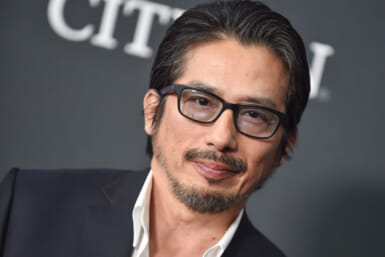On this day 60 years ago Musume to Watashi (My Daughter and I) aired for the first time on NHK at 08:40 am. The 20-minute program broadcast from Monday to Friday was the start of the channel’s famous asadora (morning dramas) that have gone on to become a national institution in this country. The current series, Ochoyan (Little Waitress), is the 103rd so far, while numbers 104 to 106 have already been announced.
The first, based on Shishi Bunroku’s novel of the same name, was about a stepfather taking care of his daughter after the death of her mother. It was one of only seven asadoras to feature a male lead – usually the drama centers around a woman chasing her dream. For the following series, Ashita no Kaze (Wind of Tomorrow) about a poor family after the war, an extra day was added, and the timeslot changed to 08:15 with every episode just 15 minutes rather than 20.
One of the most popular series in those early years was Ohanahan (Miss Flower) which debuted in 1966. The lead role of Hana, a cheerful single mother from the Meiji era, was originally supposed to be played by Mitsuko Mori but a sudden illness meant she had to pull out just before shooting giving Fumie Kashiyama the chance to step in. The latter became a national icon off the back of the series which had an average audience rating of 45.8 percent, peaking at 56.4 percent. With so many people watching there was a sudden decrease in water usage starting at 08:15 am every morning.
https://www.youtube.com/watch?v=MSHyJsS7lTo
Oshin: A Global Phenomenon
While those numbers are impressive, nothing can compete with Oshin, first broadcast in March 1983, which still holds the record for the highest average rating for a drama in Japanese television history (52.6 percent) and the highest for a single episode (62.9 percent). Far more than a domestic hit, it has been aired in more than 70 countries around the globe. Singapore was the first place outside Japan to show it in September 1984, followed by Thailand and China, where around 200 million people reportedly watched the series including future president Hu Jintao.
Loosely based on the life of Katsu Wada – co-founder of the supermarket chain Yaohan – the story centers around Shin Tanokura (Oshin) who is sent to work at the age of seven to support her sharecropper family. The young girl played by Ayako Kobayashi (and later by Yuko Tanaka and Nobuko Otowa) goes through many hardships, is bullied at school and treated harshly by relatives, yet still perseveres to become a successful businesswoman. In an interview with NHK, former U.S. President Ronald Reagan spoke about Japan’s “tenacity, endurance and sheer hard work,” qualities he said that were “beautifully portrayed,” in the popular drama Oshin.
A country known at the time for its booming economy and advanced technology, international audiences were fascinated to see a different side to Japan. In a monastery in Belgium nuns changed their prayer times so they could watch the show. Husbands in Indonesia complained that their dinners were being served late because of the program while in Egypt a power outage during the drama led to people rioting as they were angry at missing an episode. Viewers in Vietnam became so familiar with the program they started referring to family helpers as “Osin” rather than “Người giúp việc”.
Oshin proved particularly popular in Iran where ratings were reportedly close to 90 percent and it was joked that even Iraqi missiles couldn’t tear people away from their screens when it was on. Citizens who were experiencing devastation and shortages due to the war could empathize with the lead character and second-hand clothing markets were named after her around the country. In 1989 on the birthday anniversary of Fatimah, daughter of the prophet Mohammad, an Iranian radio station asked about the best role model for women in the country. When one unidentified respondent said Oshin because Fatimah’s time was too far back in history, supreme leader Ayatollah Khomeini was furious and allegedly ordered those involved in the report to be executed for being anti-Islamic. Following an appeal, they were pardoned yet did spend years in prison and received lashings.
21st Century Drama: A Changing Landscape
With so many more options from streaming sites and satellite TV, NHK morning dramas can no longer get the kind of viewing figures they garnered in the 1980s, however, they have remained relevant in the 21st Century, continuing to attract significant audience numbers. After a bit of a lull in the mid-late 2000s, ratings have been strong in the past decade thanks to shows such as Carnation with Machiko Ono based on the life of fashion designer Ayako Koshino and Umechan Sensei starring Maki Horikita about a young woman striving to be a physician in post-war Japan.
One of the most popular series in the last ten years was Amachan (Little Ama) starring Rena Nonen which told the story of Tokyo high school student Aki Amano who moved to the Sanriku Coast in Tohoku to become a female diver, returned to the capital to try and make it as an idol and then went back to Tohoku to help revitalize the area after the 2011 Earthquake and Tsunami. The program reportedly helped bring 32.8 billion yen to an area that had been destroyed by the disaster. Known as a cultural phenomenon, it spawned new phrases such as “jejeje” (indicating surprise) which was chosen as one of the four words of the year in 2013.
Other notable successes in the past ten years include Gochisousan (Thanks for your Hospitality) with Anne Watanabe about a woman attempting to learn how to cook Japanese cuisine, Hanako to Anne, led by Yuriko Yoshitaka, which told the story of Hanako Muraoka, the first woman to translate Anne of Green Gables into Japanese, and Asa ga Kita (Here Comes Asa) starring Haru as Asa, a character based on social activist and businesswoman, Asako Hirooka. She played a prominent role in transforming Kajimaya, one of Osaka’s leading merchant’s during the Edo period, into a modern corporate group that included coal mines, banks and insurance companies. The show earned the highest rating for an asadora since 2000.
https://www.youtube.com/watch?v=cJ3w2B-Ys5A
Rising Stars: A Springboard to Bigger Things
Teru Teru Kazoku (Happy Family) was the first asadora to average under 20 percent in the ratings in 2004 yet despite this, the program helped launch the career of Satomi Ishihara, now one of the most recognizable faces on Japanese TV. Though female actors such as Tao Tsuchiya (Mare), Kasumi Arimura (Hiyokko – Bloom) and Mei Nagano (Hanbun, Aoi – Half Blue Sky) had already made names for themselves before playing the lead in an asadora, doing so helped propel them to even greater prominence in this country, acting as a springboard for future successes.
Appearing as a heroine in an asadora is a big deal here and competition to secure the main role can be fierce with auditions often attracting thousands of hopefuls. As well as performing in the drama, the winning actor becomes a spokesperson for NHK and takes part in various events and programs sponsored by the channel including its famous New Year’s Eve special show, Kohaku Uta Gassen. The first, and so far, only foreigner to have been selected is Charlotte Kate Fox in Massan who played Ellie, a character based on Rita Taketsuru née Cowan, wife of the founder of Nikka Whisky.
“Of course, I feel pressure – from three different countries actually,” Fox told TW before the drama aired seven years ago. “I want to properly represent myself as an American and do what I can as an actor to respectfully portray Ellie’s Scottish heritage as well as accurately portraying her assimilation into Japanese culture. On top of that, as the heroine of a national Japanese drama, I have a duty to Japan as well.”
60 Years On: The Drama Continues
Star of the current asadora, Ochoyan, is Hana Sugisaki who is known for movies such as Blade of the Immortal and Her Love Boils Bathwater. She plays Chiyo Takei, a character based on Chieko Naniwa, an actress who appeared as a geisha in several films, most notably Akira Kurosawa’s Throne of Blood and Keiji Mizoguchi’s A Geisha. Shooting for the drama began on April 2 last year, however, due to the State of Emergency it was suspended until late June. Initially due to premiere on September 28, it was pushed back to November 30 and will run until May 15 this year.
The 104th asadora, Okaeri Mone (Welcome Back Mone) is due to start two days later with 19-year-old Kaya Kiyohara taking on the lead role as Momone Nagaura. Unlike most other morning series, this one is set in the present time. An original script written by Naoko Adachi (Code Blue: The Movie), it is about a young girl from the island of Kesennuma Bay in Miyagi prefecture who decides to become a weather forecaster. After finally passing the exam, she moves to Tokyo to work for a private company but eventually returns home to help with an approaching typhoon.
Okaeri Mone will be followed in the autumn by Come Come Everybody which depicts the lives of three generations of women all of whom have close links to the English radio lessons that began in 1925. Written by Yuki Fujimoto, who also penned the 2007 asadora, Chiritotechin, it will be the first morning drama to feature three leading actors as different characters – Mone Kamishiraishi, Rina Kawaei and Eri Fukatsu. It’s also been announced that Yuina Kuroshima will star in next spring’s asadora, Chimudondon, about a girl who dreams of opening an Okinawan restaurant in Tokyo. The series has been timed to coincide with the 50th anniversary of Okinawa’s return to Japan.









